If you are looking for a low-maintenance yet stunning houseplant, then you should grow peace lilies! They are the ultimate indoor houseplant for almost everyone, everywhere!
The peace lily is a tropical perennial plant that comes from the Spathiphyllum genus. Unlike their name-sake, peace lilies are not true lilies. They are only hardy in USDA Zones 11-12, so most people keep them indoors as potted houseplants in most locations.
Peace lilies are perfect for brightening up any room they are in, but they are for more than just looking pretty. In fact, they are also great for helping to clean the air by filtering pollutants.
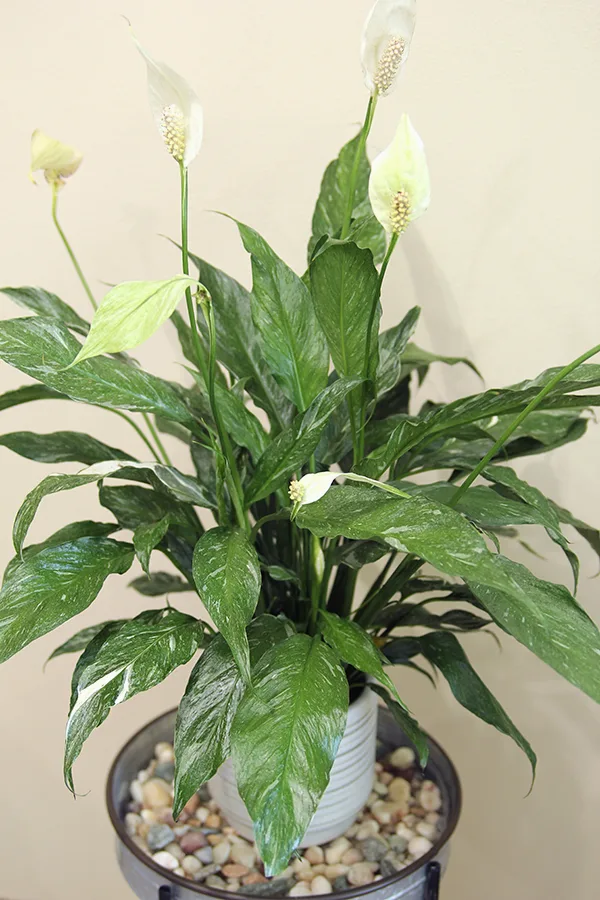
You can find peace lilies in greenhouses and nurseries at almost any time of the year. You can also easily divide and propagate lilies to create even more plants for free.
Whether you are looking to add some color and texture to your home or office space or you want to help naturally clean your indoor air, peace lilies are the houseplant for you! Read on to find out just how simple it is to care for this stunning beauty.
Varieties of Lilies
There are many different varieties of peace lilies within the Spathiphyllum genus. The different varieties feature different mature sizes, leaf patterns and designs, and even slight color variations.
You can find smaller varieties that grow only to around a foot tall to varieties that get as massive as 6 feet tall. Their mature leaves can range from as small as 5 inches long all the way up to around 25 inches in length.
Most peace lilies feature large, oval-shaped leaves that are glossy and dark green in color. Some produce leaves that are smooth and glossy while others are rough and textured. There are even variegated peace lilies that produce leaves with green and white patterns.
Be sure to check out the end of this article where you will find 5 stunning varieties that would look great with any home decor. Any of these varieties look great when grown in the same room as other easy-care houseplants like Spider Plants or Pothos. Looking for more of a challenge? Then be sure to check out Peacock Plants, another houseplant with stunning foliage.
Peace Lily Flowers
When a peace lily reaches maturity – in about three to five years – it can produce attractive white spathes. The spathe is actually a leaf bract that encloses the actual flower. It typically starts out light green and then changes to cream or white as it ages. Before it dies, it will turn back to light green.
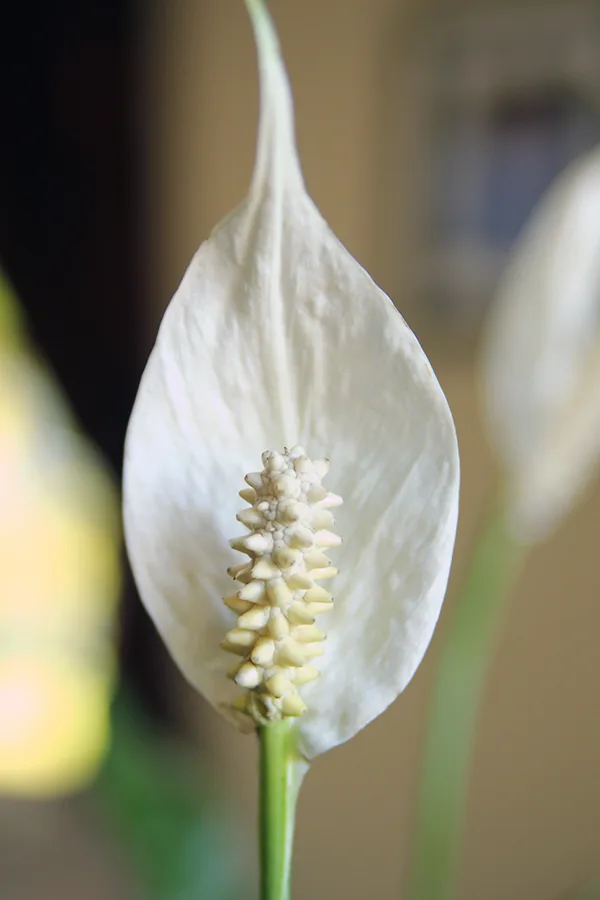
The actual flower, called a spadix, is enclosed within the spathe. The tiny flowers resemble a spike of little bumps in a group that wraps around the stem. Alone without a spathe, the flowers are not very visually appealing.
When they are grown outdoors, peace lilies bloom only in the spring. However, when they are used as indoor houseplants, they can bloom any time of the year under the right conditions.
The flowers will last for around a month before it needs to be pruned. The spathe will actually start to brown after about 10 days, so you might start to see brown specks soon after blooming begins. After the spathe browns, you can prune the long stem back to allow the plant to focus its resources on creating new flowers.
Growers often add a hormone to immature plants to force them to flower, so don’t be surprised if you purchase a flowering peace lily only to find out it won’t produce new flowers on its own for a few years. Even without the spathes and flowers though, peace lilies still feature attractive green foliage.
How To Grow Peace Lilies
Even though these houseplants are easy to care for, they still need the right growing conditions in order to thrive and produce those eye-catching spathes and flowers.
Soil Requirements for Peace Lilies
In their native environment, peace lilies grow on the forest floor. They are used to growing in soil that has an abundance of broken-down leaf and plant matter.
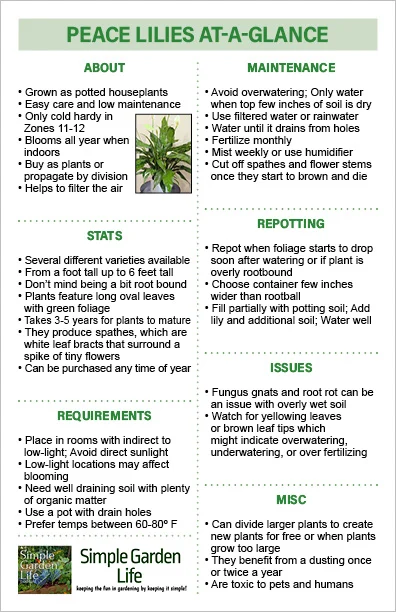
Due to this, peace lilies prefer soil that is rich in organic matter. In addition, choose potting soil that is loose and well-draining. Peace lilies do not tolerate overly moist soil very well.
Light Conditions
Peace lilies naturally grow where they receive dappled light. When grown indoors, they do not do well with direct light since this can burn the delicate foliage.
Instead, choose a location that receives bright, indirect sunlight for the best results. East-facing or north-facing windows work well for peace lilies. Avoid placing them near south-facing windows where the sunlight will be too harsh.
Peace lilies can also be grown in locations with low light, although you might have less flowering occur. They are perfect for brightening up a darker corner of a room as long as you aren’t concerned with blooming.
Watering
Peace lilies do better with dryer soils as opposed to overwatering. However, try to never let the soil dry out completely. Only water peace lilies when the top inch or two of the soil is dry to the touch. You can also use a moisture meter to see the soil’s moisture content as well. Product Link: Moisture Probe Meter
The frequency at which you water will depend on many factors. The size of your plant, its pot size, the air temperature and moisture level, and also the type of potting soil used will all go into play.

Some people will even wait until the peace lilies start to droop due to lack of moisture. This will not cause issues with the plant as long as you water them soon after the drooping begins.
It is best if you use filtered water as opposed to tap water since some peace lily varieties are sensitive to high chlorination and fluoride levels. You can also collect and use rainwater as an excellent free source of water.
Pour the water evenly onto the soil until you start to see water draining out of the holes in the bottom of the container. It’s always better to give the plants a good soaking occasionally as opposed to just a few inches of watering here and there.
Fertilizing
Peace lilies can benefit from a monthly feeding of plant fertilizer that is geared toward indoor plants. Apply the fertilizers to the soil line and avoid getting it on the foliage just like you would with outdoor plants. You can also mix the fertilizer in when it is time for watering. Be sure to read the fertilizer’s directions prior to using it.
Humidity & Temperatures
Due to being native to forests, peace lilies do like moist air. Use a spray bottle to mist the leaves every week or so to help raise the humidity levels. You can also use a cool mist humidifier to increase the air moisture. Remember to use distilled, filtered, or rainwater.
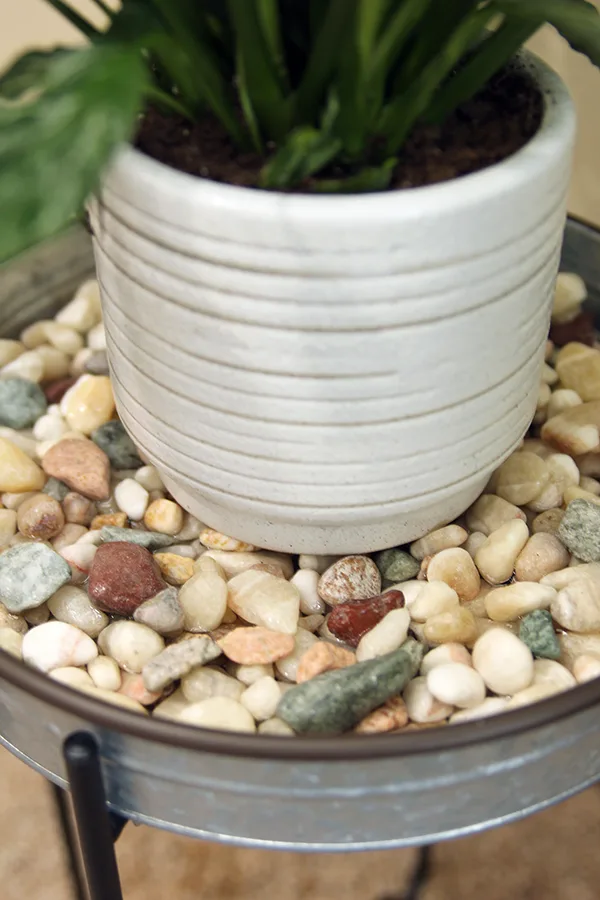
To easily increase the humidity levels, you can also place plants on top of a tray filled with rocks. Add enough water to go about halfway up the rocks and place your potted peace lily on top.
Peace lily plants grow best in temperatures that range between 60 and 80º Fahrenheit (16 to 27º Celsius). Avoid keeping them in locations that have cold drafts or next to heater vents.
Repotting
Unlike some indoor plants, peace lilies are content with being a bit rootbound. If your plant starts to wilt or drop leaves soon after watering, it might be time to repot, however. You also should repot your peace lily if you start to see the roots growing out through the container’s drainage holes.
Choose a new container that is only a few inches wider than the plant’s rootball. Make sure that the pot has several drain holes to allow excess water to escape when watering.
Fill the container a third of the way with a well-draining potting mix. Add the peace lily so that the rootball is at the same level as it was previously. Fill the remainder of the pot with your soil, leaving a bit of space around the top to allow for easy watering.
Water the plant until you start to see the excess water drain from the holes in the bottom of the pot. Once the water stops draining out, your peace lily is good to go.
Dividing Large Plants
You can also choose to divide your peace lily when you go to repot if the plant has gotten too large for its location and container. This is a great way to produce more plants – all for free! Dividing can occur at any point of the growing season for indoor peace lily plants.
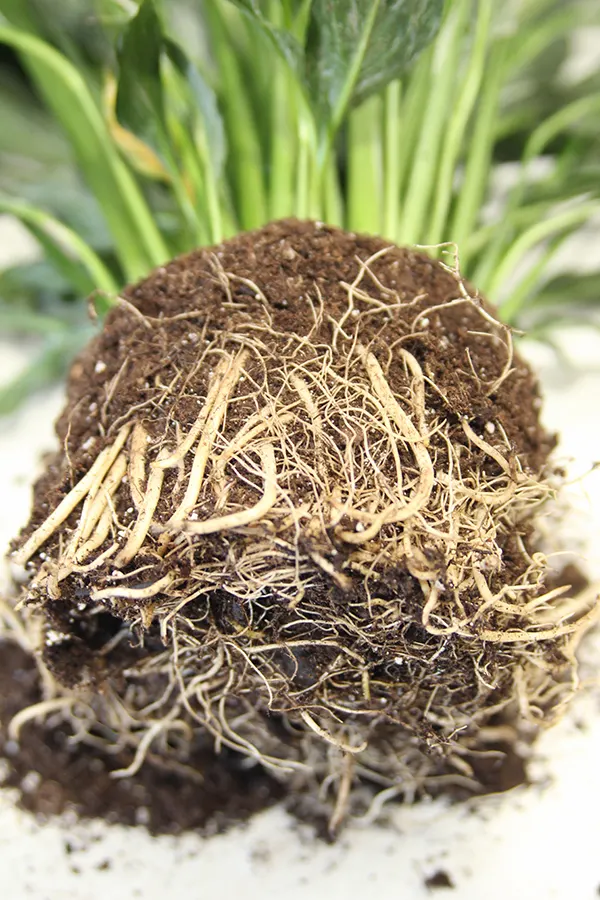
When you remove the plant from its current container, simply divide the rootball in half with a hori hori knife or another sharp knife. Make sure that there are several leaves attached to both pieces of the division. This will give you two smaller peace lily plants that you can then repot as instructed above.
Pest and Issues
As with all houseplants, peace lilies do come with a few possible issues and pests to watch out for.
Due to their larger leaves, peace lilies can benefit from light dusting a few times a year. Simply take a damp cloth and carefully wipe down each leaf. This also helps the foliage absorb more sunlight.
All indoor plants can become victims of fungus gnats. While these pests don’t really harm the plants themselves, they can become a big nuisance for people. These pesky gnats live and reproduce on moist soil. Proper watering schedules and allowing the top few inches of soil to dry out in between watering will help avoid fungus gnats.
If you start to see brown edges on the foliage of your peace lily, there is a chance that the plant is getting too much sunlight. Move the plant to a location that receives less sunlight. Brown leaf tips and edges can also be an indication of over-fertilization or lack of water and humidity.
Overwatering or underwatering can also cause the foliage to start to yellow on peace lilies. It is also natural for older peace lily leaves to turn yellow as they age. Simply trim them back to the base of the plant. Having several leaves yellowing might also be a good indication that it’s time to repot if you haven’t in a long while.
Word of Warning – How To Grow Peace Lilies
Peace lilies are considered toxic to pets and humans, especially if consumed in large quantities. They contain a compound (calcium oxalate) that causes stomach and respiratory issues if enough is consumed.
Be sure to keep them in a location that is away from small children. Also, keep them away from pets that might try to nibble on the foliage.
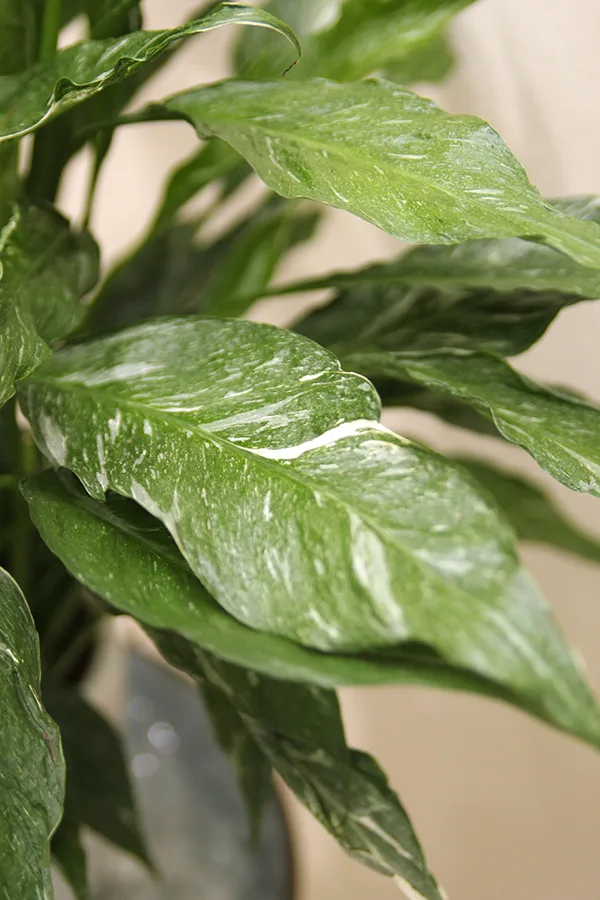
5 Stunning Varieties
- Spathiphyllum ‘Wallisii’ – This variety is one of the more popular types of peace lilies. It grows from 24 to 36 inches tall.
- S. ‘Petite’ – This smaller peace lily packs a lot of beauty in a small package. It grows only to around a foot tall.
- S. ‘Sensation’ – This is the largest variety of peace lilies available. It grows to a massive 6 feet in both height and width.
- S. ‘Domino’ – This variety features variegated foliage in colors of dark green with splashes of white on each leaf. The leaves have a slightly rough texture on them and grow up to around 20 to 30 inches tall.
- S. ‘White Stripe’ – Unlike most peace lilies that feature solid dark foliage, this variety has a stunning white line down the middle of its leaves. It is a medium-sized plant.
Feel free to download, print out, or save our Peace Lilies At-A-Glance sheet.
Follow Our Facebook Page For Even More Great Tips! Simple Garden Life Facebook Page
Simple Garden Life is a website dedicated to keeping gardening fun, simple and enjoyable! We publish two new articles each week along with a new garden podcast episode every two weeks. This article may contain affiliate links.
